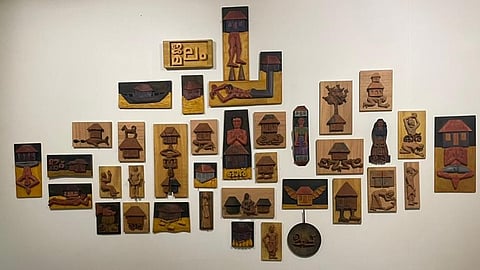

Tidal flooding has affected over 20,000 households in coastal Kochi since 2012
Art–science project KabhumM!!! highlights community experiences and environmental data
Researchers warn the city’s low-lying zones are increasingly vulnerable to sea-level rise
Kochi’s coastal suburbs and villages have for years been facing slow but persistent flooding, with seawater seeping into homes, courtyards and farmland, sometimes up to 15 kilometres inland. The phenomenon, once rare, has become routine, with the tide rising even on clear days in areas such as Puthenvelikkara, Chellanam, Kumbalanghi and Paravur.
Scientists say the flooding reflects a broader global trend: Oceans absorb more than 90 per cent of the excess heat from greenhouse gas emissions, leading to glacier melt and thermal expansion. Sea levels are now rising by nearly 5 millimetres a year. India, Bangladesh and China are among the most vulnerable nations.
In Kerala, high-tide flooding has affected parts of Ernakulam district since 2012. Studies by the Kochi-based firm Equinoct estimate that more than 20,000 households across 25 local bodies are now affected from November to June, long before the monsoon begins. Despite the scale of the problem, there is no comprehensive system to record these losses or coordinate relief.
What began as seasonal flooding has become a chronic environmental crisis, disrupting lives and livelihoods across the region.
Against this backdrop, a month-long exhibition titled KabhumM!!! has opened at the Kerala Museum in Kochi. The event seeks to document and interpret the growing threat of tidal flooding through art, community engagement and data-driven research.
KabhumM!!! — short for Kathunna Bhoomi Malayalam or Burning Earth — is curated by artist and educator Radha Gomaty and hosted by Resilient Kochi, a collaboration of artists, scientists and community organisations. It includes inputs from Equinoct Community Sourced Modelling Solutions, a local climate-tech start-up and the Community Resource Centre in Puthenvelikkara, both involved in coastal resilience initiatives.
Equinoct’s co-founder and chief executive officer CG Madhusoodhanan described the exhibition as “a living laboratory” that links scientific data with community experience. “Data alone cannot stir the heart and art alone cannot inform policy,” he said. “KabhumM!!! is where these languages intersect. It allows us to translate the lived experience of tidal flooding into something both measurable and meaningful.”
At the centre of the exhibition is The Flooded House, a reconstructed home based on real dwellings in flood-affected areas. Visitors walk through waterlogged rooms with displaced furniture, half-packed belongings and damp books, intended to illustrate how families live through months of inundation each year.
“This is not a simulation,” said Madhusoodhanan. “This is reconstruction. Every object carries the memory of a household that has fought this battle silently for years.”
Equinoct’s research director Sreeja KG said the organisation first noticed the pattern in 2020. “Long after the rains had stopped, we saw water still rising in people’s homes. It wasn’t the river, it was the sea,” she said. Her team confirmed that warmer ocean temperatures had amplified tidal surges, while blocked drainage channels and harbour deepening worsened backflow.
Kochi lies at the confluence of the Periyar River, Vembanad Lake and the Arabian Sea. Its low-lying areas — barely a metre or two above sea leve l— make it highly susceptible to rising tides.
Port expansion, real estate reclamation and dredging have disrupted natural drainage and increased tidal amplitude, while the loss of mangroves — more than 95 per cent of Kerala’s mangrove cover has disappeared in a century — has removed an important natural defence.
“Climate change set the stage,” said Chillayil Jayaraman, Equinoct’s co-founder. “But human greed rewrote the script.”
The exhibition features a series of installations and performances reflecting the environmental and social dimensions of the crisis.
In AP Sunil’s Whispers of the Deep, sounds recorded from the Arabian Sea recreate the underwater noise of shifting sediments and coral decline. Artist Babitha’s installation draws on historian J. Devika’s children’s book Kadalkutty, using paper boats suspended from the ceiling to recall the region’s maritime history.
Other works, including MR Vishnuprasad’s Eviction Camp and Jalam Theatre’s Chevittorma, depict displacement and resilience among residents of flood-affected villages. The theatre performance uses testimonies from local communities and is staged in shallow water.
Organisers say KabhumM!!! will not remain confined to the museum. Replicas of The Flooded House and Chevittorma will be taken to colleges, schools and coastal panchayats. Local governments have begun using data and documentation from the project in climate adaptation planning. Workshops and community dialogues will continue through 2026.
Justice Devan Ramachandran, who inaugurated the exhibition, described it as “an education in empathy”. “We cannot rebuild the coast with concrete,” he said. “We need imagination.”
Experts warn that Kochi’s tidal flooding is a sign of how climate change and unplanned urbanisation intersect. It demonstrates how a slow-onset disaster can evolve into a long-term governance challenge.
KabhumM!!! runs until October 19, 2025. Organisers say the exhibition’s findings will feed into educational and policy initiatives aimed at improving coastal resilience.